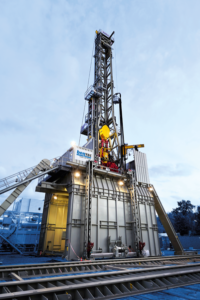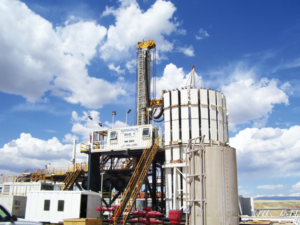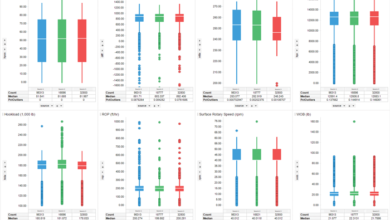Mechanization, automation guide innovations in advanced robotic technologies for the drill floor
Different approaches being taken by equipment manufacturers to pave path to truly hands-free drill floor
By Linda Hsieh, Managing Editor

The word “robot” can mean different things to different people. For many, the word might conjure images from movies or television shows – perhaps Robby the Robot from the 1960s, C-3PO and R2-D2 from the Star Wars films or, more recently, the animated Wall-E. However, at its core, a robot is simply a machine, and in that sense, robots and robotic technologies are not new to the drilling industry. “Technically, iron roughnecks have been robots from the beginning,” said David Reid, Chief Marketing Officer for National Oilwell Varco (NOV). “Simple robotics is telling a machine to do something and leaving it alone to carry out multiple tasks, and we’ve had that since the ’90s.”
What’s changing now is how much more can be done with robots, as well as how humans interact with them and how robots interact with other robots. “That’s where tremendous focus is going to be moving forward,” Mr Reid said. “Lots of people can build oilfield iron. It’s controlling it and making it collaborative and learn how to optimize itself that are farther up the software curve.”
Much of the industry’s recent efforts to advance robotics have been happening at the convergence of two other key trends: mechanization and automation. Dieter Wijning, Product Manager Drilling for Huisman, describes it this way: “Mechanization is basically the physical labor of human beings replaced by machinery, but the humans still control the machines. Automation is the next step, so the human is taken out of the loop, and the computer controls the machine according to a fixed plan. When you talk about robotics, the plan is not fixed anymore. Different tools and different steps in the process can be changed to optimize the whole process of the robot.”

In terms of both automation and robotics, the drilling industry is still generally considered to be in the very early stages, however. “Technologies used on the drill floor currently have rather low levels of automation, typically LOA 1-3,” said Ekaterina Minyaeva, Drilling Automation-Subsurface and Wells for OTM Consulting. LOA refers to levels of automation, rated on a scale of one to 10. LOA 10 indicates a fully autonomous system with artificial intelligence. LOA 5-6 indicates machinery with human-machine batch decision-making processes. “This means that the human will input a command, and the machine will deliver it whilst consulting with the human if there are any unexpected obstacles or changes in the environment,” Ms Minyaeva explained. LOA 1-2 is manually controlled machinery.
“Indeed, rig machinery with an intelligence higher than LOA 3 is extremely rare,” she said.
Change is in the wind
Norway-based Robotic Drilling Systems (RDS) is gearing up to deliver a full robotic drill floor system to the Ullrigg Drilling and Well Centre, operated by the IRIS research institute, in 2018. The system will be able to replace all manual operations on the drill floor, said Lars Raunholt, Founder and VP of Business Development for RDS.

There are four main components in this system. First, the robotic pipe handler is used to pick up pipe, including casing and tubing. Using handling tools, such as grippers or spinner grippers, it can spin pipe directly into or out of the stick-up. The second and third pieces are the electric roughneck and the multi-size elevator, which joins the pipe together and hoists the drill string up and down, respectively. Finally, there’s the drill floor robot, which will make all pipe and tool operations on the drill floor hands-free.
“The drill floor robot replaces all manual operations that are done today,” Mr Raunholt said. “For instance, if a sub needs to go into the drill string, that is often a manual operation where you need to have a small hoist on the drill floor. But the drill floor robot can come in, pick up that sub and spin it into the drill floor without any hands touching it.”
The entire system is electrically powered, which provides for a high level of precision in the control of each robot. Sensors and actuators are also built into the inside of each machine, not added to the outside as commonly seen with oilfield equipment.
Further, RDS has developed a dynamic robot control system – this is a critical piece of the system that provides for seamless and flexible operations. “For robots that are used in car assembly plants, for example, they basically do the same operation over and over again. If they want to do a new operation, you need to call in a couple of robot engineers to reprogram it,” Mr Raunholt explained. With the RDS system, the same robot can be used for various operations, and reprogramming can be done within minutes. “If you had planned to run one kind of pipe into the well but then the plan changes, it’s very easy to tell the robot to pick up another piece of pipe.”

The key is using a control system that provides a 3D world for the robots, he added. “The robots know where each of the other robots are at any time. That’s what makes them able to work together seamlessly. “We tell them to go pick up that sub, and it calculates the route to go there itself and how the joints should operate on the robot in order not to collide with any other robots or with other things on the drill floor. That’s a big difference. These robots are essentially reprogramming themselves.”
In preparation to deliver a full robotic system to the Ullrigg test center next year, each component of the system is first being qualified separately. In Q2 2017, RDS installed the first robotic pipe handler on a land rig in the US, and the first offshore pilot of the electric roughneck is slated for 2018, on a drillship. In August, the company also initiated the installation of the drill floor robot on Odfjell Drilling’s Deepsea Atlantic semisubmersible. This is the first offshore installation of the drill floor robot.
“The goal is to replace between 1,000 and 2,000 manual operations on the rig in the first year,” Mr Raunholt said. The company hopes to eventually expand that to 5,000 operations per year by developing additional handling tools for the robots. Examples of manual operations that can be replaced now include handling of subs for the drill string, including stabilizers and lifting subs; handling of safety clamps; and handling of manual slips.
The drill floor robot has already been running at the Ullrigg test center for two years, he added, noting that the Odfjell installation is expected to provide critical user input. “We feel that the robots are where we want them to be from the technical viewpoint, but what we really need now is the user’s feedback.”
RDS expects that crews will need only three to five days of training to operate these robots due to the simplicity of the human-machine interface. The driller or assistant driller needs to give only overall “what to do” commands to the system, Mr Raunholt explained. “These commands focus on the various overall work tasks and not on the individual machines. The control system distributes overall commands to the various machines. The various machines control themselves.”

Besides the obvious safety benefit of having hands-free operations, the robotic system is also expected to provide improved efficiency. For the task of handling and spinning a lifting sub, for example, manual operation would require at least two people and a winch and take two minutes to complete. “The robot handles this operation in 30 seconds. This is something we have been able to prove during our test in the workshop and on a land rig,” Mr Raunholt said. “We are starting to see the business case and to prove the value.”
Combining autonomous, human-controlled robotics
At Huisman, the approach to automation and robotics takes a slightly different route. “There are basically two ways of controlling machines,” Mr Wijning said. “Autonomous robotics provides repetition, force and precision. Basically, the robots are working according to a predefined playlist. The operator only supervises, but he can always interfere. On the other hand, we also have human-controlled robots, which provide dexterity and ingenuity.
“In the current industry, robots already work side by side with humans, and the key is to recognize the strength of each other,” he continued. “The combination of both often increases productivity, safety and flexibility. We strongly believe in the combination of autonomous and human-controlled robotics.”
Exemplifying this approach to automation is the Huisman Innovation Tower, which evolved out of the company’s original Multipurpose Tower (MPT) from the late 1990s and early 2000s and the Dual MPT (DMPT) from 2010. Huisman has been working on further improvements of the DMPT and the design vessel. This resulted in the HuisDrill 12000 drillship design.

With the DMPT, pipe is brought with the setback drums to the racker, instead of translating the racker to the pipe. Therefore, the rackers have only three motions: up and down, rotating, and telescoping in and out. There is also a split drill floor that provides clear separation between the two primary work areas. “This allows for humans to work safely on the construction floor, while the robots operate on the main drill floor,” Mr Wijning explained.
With the new Innovation Tower, these features have been kept, but the hookload has been raised to 3.5 million lb, and the system can now handle 180-ft stands, instead of 90- or 135-ft stands. These longer stands of pipe reduce the number of connections required and increase tripping speed, even in restricted mode. With the full-scale prototype Innovation Tower that Huisman built last year at its facility in Schiedam, The Netherlands, “we can already do fully automated tripping at 5,600 ft/hr, and we are working on increasing the speed. Our goal is 6,000 ft/hr, fully automated.”
On each of the construction and main drill floors, there are up to eight identical robotic manipulators – four in each corner. They can be operated individually or synchronized, and manually or in an automated mode. “When two or three of these manipulators are synchronized and equipped with grippers, they act as a pipe racker,” Mr Wijning explained. Each robot can hold various tools, such as a dedicated pipe gripper, drill pipe spinner/wrench, casing makeup modules or riser-running tools. “The tools can be exchanged very fast. We clocked around two minutes for exchanging the tool, and the tools which are not being used can be parked in the tool rack on the side.”
Huisman also recently launched a wide-range power slip, which can grip pipe from 3 ½ in. to 9 ¾ in.-OD without changing inserts. “Further, the unit can open to 21 inches, which creates a lot of space for letting large elements, such as bits and stabilizers, to pass through the slips,” Mr Wijning said. A second clamp is present, which enables quick changes from drill pipe to casing or can serve as a backup for the first clamp. “According to oil companies we have talked to, this clamp alone can save 2-3% or maybe even 4% of the total well construction time,” he said.
Currently, Huisman is working to give the Innovation Tower capabilities to handle 60-in. casing in 180-ft stands, as well as 150-ft riser joints. Enabling easier and faster completions is also on the horizon. “The total absence of a V-door, together with the flush drill floor and work deck, enables easy and flexible rig-up of various completion tools,” he said. “With current market conditions, there is a need for change… We think when the industry starts to build rigs again, there will definitely be much more robotics involved.”
Connecting the surface and downhole

Automation developments at NOV aren’t focused so much on building specific pieces of robotic machinery as on creating an entire drilling ecosystem – encompassing both the surface and the downhole. You might say that they see the drilling rig itself as becoming one giant robot.
Whereas programmable logic controllers (PLCs) and solid state drives have been automation enablers in years past, nowadays it’s things like high-performance computing and advanced sensors that are paving the path to the future. “Cameras are a good example of where we are and where we’re going in terms of sensors,” Nick Morriss, NOV Commercialization Director, said. People think of cameras as capturing images, but what they really capture are data streams. “If a machine has sufficient computing capacity and it can process the data coming in from the camera, you can utilize cameras that are already on the rig as different types of sensors.”
Such innovations are leading to changes in the human-machine interface. For example, rather than a human having to tell a machine to turn left or right, or to move forwards or backwards, to pick up a piece of pipe, now a visual interface can be used to direct the path of a pipe-handling system. This can be as simple as moving dots on a touch screen. “The user experience of controlling these machines is where the most innovation is occurring right now,” Mr Morriss said.
Eventually, artificial intelligence and machine learning will come into play, as well. “There’s a lot of work still coming,” Mr Reid said. “But if you connect the surface to live data being streamed from the well, suddenly the robots can be sensitive to what’s happening at the bit.” NOV is now working on developing complete drilling systems where each component of a drilling rig can know what’s happening with other components throughout the drilling operation. With this kind of interconnectedness, layers of increasingly sophisticated intelligence can be added. Ultimately, “the system will know what’s best for the well,” he said.
NOV’s NOVOS system – a process automation platform – marks a key step toward creating this type of interconnected ecosystem. “If you consider the drill pipe, the bit and everything else to be part of one drilling robot, when it feels like something is going wrong in the well, it tells the machines what to do,” Mr Reid said. “It senses when something is going wrong in the wellbore, and it makes its own decisions on how to fix the problem, without humans having to be involved.”
Certainly, human operators will have to set safe-zone parameters, but within those envelopes, the machines will learn to optimize themselves and their performance. The result will be consistency, and over time, that will add up to higher efficiency and fewer failures.

The key challenge, not surprisingly, lies in people. “There are so many people who have to provide their input into the construction of the well,” Mr Morriss said. “There are people interested in the quality of how the machine works. There are people interested in how the safety of the machine works. There are people interested in speed, and there are people interested in other performance metrics. Each one of those people wants to have a say in how that machine will operate – either individually, or in parallel or in sequence with another machine. Without a control system that allows all of those people to provide their input, you get to a point where the driller is in charge. That’s kind of where we’re at today. The driller is ultimately the controller of the machines.”
To overcome this challenge, changes to traditional roles will have to be made. In an automated, self-learning system, the human driller will have to give up certain control to the machines. “Today what we have is, for example, a speed controller – a single joystick that runs multiple machines. They will go faster or slower, but they all do either the same things or linear things,” Mr Reid said. “Where we’re going is those machines are going to become self-aware and work as part of a process. They will consult with the driller, who’s going to be a process operator, not a machine driver.”
Culture, interoperability, cost are big challenges
Indeed, cultural and mindset shifts will play significant roles in helping the industry to achieve a truly hands-free drill floor and a fully automated drilling operation. “Our industry continues to hold on to a false perception that manual operation is faster,” said Karsten Heidecke, Director of Engineering, Well Integrity at Weatherford. The company is currently developing pipe makeup equipment capable of automatic operation.
“The industry is far behind compared to other industries. Automation has increased efficiency in many areas, and the benefits are quantifiable in other industries, but the data available for our industry is limited,” Mr Heidecke said. In addition to cultural challenges, there’s also a lack of standardized and open interfaces in rig control systems. “This is a large hurdle that is hard to overcome,” he emphasized. “In some integration cases, hardware, software, sensors and controls are not utilized to their full capability due to the lack of an open architecture. Interfaces between different parties need to be standardized, and signals should be logged.”
Cost is another barrier, particularly in this current downturn, with most companies cash-strapped and hesitant to spend money on new or emerging technologies. “I think the industry is eager to see improvements. However, there is some hesitation because previous large investments into mechanization did not result in the expected efficiency gains,” Mr Heidecke said. “It may take time before we see investment on a large scale.”
Building single components that can be combined
A newly developed offline stand builder is among three major drilling components being supplied by Bentec this year to Xtreme Drilling for the upgrade of its three 850XE drilling rigs. “Our new offline stand builder allows the drilling crew to pick up and build a stand in parallel with the drilling process,” Bentec COO Arend Lödden said. The project, under which Bentec will also supply 500-ton AC top drives and remote-controlled iron roughnecks to Xtreme, will be the German company’s first foray into the competitive North American rig equipment market.

Integrated smart controls, including an anti-collision system, have also been developed to work in conjunction with all three components, using a total of 40 to 50 mounted sensors to detect the condition, load or position of the equipment. This information is then fed back into the control unit. “The whole idea of the anti-collision system is firstly to ensure that the driller operates the equipment safely and in such a way that there are no clashes between the different pieces of equipment,” Mr Lödden said. “This is very important because the operation can become quite complex when the offline stand builder is in operation as there are a lot of things going on at the same time.”
Further, “the controls define the various moving sequences and, in parallel with this, the movements of the different functions. This increases the drilling speed and results in superior cycle times,” he added.
The offline stand builder, which was developed over an eight-month period, can also assemble drill pipes and drill collar stands in parallel with the drilling process. “It can even prepare casing in doubles for the next phase. This leads to tremendous time-saving opportunities,” Mr Lödden explained.
The offline stand builder has been designed so that it can be adapted to existing masts with some modifications. This was an important lesson learned from Bentec’s experience with the T-700 rig, he added. “Following the design and build of our fully automated T-700 rig, we came to the conclusion that we would build more single components that could be combined to work in an integrated smart control process,” Mr Lödden said. The T-700, which is owned by KCA Deutag, has recently been deployed on geothermal drilling projects in Germany and The Netherlands.
Because of the additional investment required to adopt highly automated equipment, rig dayrates will likely need to increase before drilling contractors fully embrace such innovation, Mr Lödden said. “Whilst these rigs are much more efficient, I think we still have to prove that these new drilling automation technologies will be very competitive and that the total life cycle cost, when you factor in performance gains, will be better than the alternatives,” he said. “However, once you also add in the improved safety performance, operators will really notice the benefits, and this will trigger further use of these technologies.”
Safety vs efficiency
Safety and efficiency are often touted as the primary benefits of automation, but so far at this point in the industry’s automation journey, the gains made have overwhelmingly been on the safety side. “If we compare the performance of an old drilling rig and modern rig, I see that there is a huge difference in terms of safety but not the same huge difference in terms of performance,” said Stefano Ferrari, Technical Director at Drillmec. He believes that safety can be improved by up to 75% with today’s automation technologies, while efficiency gains typically fall in the 15-20% range.
This won’t change unless the industry makes significant changes in other elements of a drilling operation – such as the downhole tools, he said. “Those elements, like the drill pipe and drill bit, are the same whether you have an automated rig or not.”
What automated equipment can bring, however, is consistency. Whereas manual rigs depend on the skills of the human driller to achieve high levels of performance, automated rigs are not limited in this way. “Our standard machine that works with single pipe can handle about 35-36 joints per hour. The fully automated version can increase this speed a little, but the real advantage is not with peak performance but in average performance,” Mr Ferrari emphasized.
A human driller may be able to drill at a peak speed of 35-36 joints per hour, but “in our experience, the peak speed of 35-36 joints becomes approximately an average of 28-30 joints per hour over a period of eight hours. With an automated system, the speed is consistent.”
In 2015, Drillmec launched its HH Series rig featuring the capability for completely automatic trip in/trip out of the drill string. The vertical pipe rack delivery system on the rig is integrated with the top drive through an automated pipe handler that rotates within the system. The top drive is equipped with a torque wrench for making up drill strings and has a horizontal displacement capability for moving pipe between the center hole and mouse hole. The pipe rack consists of mobile bins with the pipe handler installed on a vertical rotating tower in the middle. Clamps grab the drill pipe from the bins and transfer them to the mouse hole according to the preset trip plan.
“The idea was very simple: Reducing direct people involvement in operations means reducing risks for people,” Mr Ferrari said. “Historically, the job on the drill floor was based on a very heavy and physical intervention of operations in all activities, keeping them constantly exposed to a number of risks: dropped objects, moving machineries, high-pressure fluids, etc.” By removing people from direct exposure, risks are significantly reduced.
Looking toward future developments in drilling automation, Mr Ferrari said the industry should look to other industries and adopt existing technologies wherever possible. “I believe that there are a lot of things the drilling industry can learn from other industries. There are a lot of industries where the level of robotization is very high. There is space on today’s drilling rigs to improve the robotic level of these machines.” DC
DC Editorial Coordinator Eva Vigh contributed to this article.






